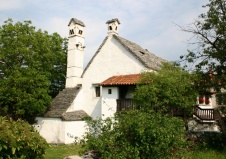 |
|
 |
|
| About · Contact · Help · Desk · ⚙ · 3,562 articles | Contents · A–Ž index |
(English proofreading & corrections 1 on version for presentation) |
|||
| Line 28: | Line 28: | ||
}} | }} | ||
{{Teaser| | {{Teaser| | ||
| − | [[Škratelj Homestead]] in Divača features a permanent exhibition on Slovene movie star Ida Kravanja (stage name [[Ita Rina]]), which was conceived by the [[Slovenian Cinematheque Museum Department]] and opened in [[Established::2000]] | + | The [[Škratelj Homestead]] in Divača features a permanent exhibition on the Slovene movie star Ida Kravanja (stage name [[Ita Rina]]), which was conceived by the [[Slovenian Cinematheque Museum Department]] and opened in [[Established::2000]] as a result of support from the [[Ministry of Culture]], the [[Municipality of Divača]] and the [[Institute for the Protection of Cultural Heritage of Slovenia, Nova Gorica]]. There are plans for the permanent exhibition on the actress to be supplemented by the '''Museum of Slovenian Film Actors''' which will also include a small cinema hall for screenings and workshops. The renovation is supported by a grant from the Norwegian Financial Mechanism. |
[[Image:Ita Rina poster.jpg]] | [[Image:Ita Rina poster.jpg]] | ||
| − | '''Ita Rina''' (1907 | + | Born in the village of Divača, '''Ita Rina''' (1907–1979) was the first Slovene to achieve international star status – her heyday was in the late 1920s when she starred in the film ''Erotikon'' (1929) by Czech director Gustav Machaty, which enjoyed major box-office success both in Europe and in the USA. |
}} | }} | ||
| − | ==Škratelj | + | ==Škratelj Homestead== |
| − | The architecture of Škratelj | + | The architecture of Škratelj Homestead and its courtyard (''borjač''), a monument of 17th-century Karst architecture, is well-preserved. In the early part of the 20th century the homestead was the biggest and the most important house in Divača, a village resting on the edge of the Divaška Valley. |
| + | |||
| + | The exhibition on the first floor presents the life of Ita Rina and the development of Slovene film during her day. | ||
==Ita Rina== | ==Ita Rina== | ||
| − | The young Slovene actress Ita Rina first lived in Berlin, at that time centre of European film industry, and her debut was in the role of a chambermaid in ''Was die Kinder ihren Eltern verschweigen''. After ''Erotikon'' she performed in the first Czech sound film ''Gallows Toni'' in 1930. She declined an invitation from Hollywood and instead | + | The young Slovene actress Ita Rina first lived in Berlin, at that time the centre of the European film industry, and her debut was in the role of a chambermaid in ''Was die Kinder ihren Eltern verschweigen''. After ''Erotikon'' she performed in the first Czech sound film ''Gallows Toni'' in 1930. She declined an invitation from Hollywood and instead got married, changed her name to Tamara Djordjević and moved to Belgrade. After World War II she starred in in several Yugoslav theatre productions and the Yugoslav film production ''War'' (1960), however she never managed to regain her earlier fame. In 1979 Ita Rina died in Budva, and was buried in Belgrade. |
| Line 51: | Line 53: | ||
==External links== | ==External links== | ||
| − | *[http://www.muzejdivaca.si/eng Divača Museum website] – Museum of | + | *[http://www.muzejdivaca.si/eng Divača Museum website] – Museum of Slovenian Film Actors under construction |
| − | *[http://en.wikipedia.org/wiki/Ita_Rina Ita Rina | + | *[http://en.wikipedia.org/wiki/Ita_Rina Ita Rina on Wikipedia] |
*[http://www.eeagrants.org/id/1118 An article at the EEA Grants page] – ''Bringing Slovenian film history into the light'' | *[http://www.eeagrants.org/id/1118 An article at the EEA Grants page] – ''Bringing Slovenian film history into the light'' | ||

This logo is missing!
If you have it, please email it to us.
The architecture of Škratelj Homestead and its courtyard (borjač), a monument of 17th-century Karst architecture, is well-preserved. In the early part of the 20th century the homestead was the biggest and the most important house in Divača, a village resting on the edge of the Divaška Valley.
The exhibition on the first floor presents the life of Ita Rina and the development of Slovene film during her day.
The young Slovene actress Ita Rina first lived in Berlin, at that time the centre of the European film industry, and her debut was in the role of a chambermaid in Was die Kinder ihren Eltern verschweigen. After Erotikon she performed in the first Czech sound film Gallows Toni in 1930. She declined an invitation from Hollywood and instead got married, changed her name to Tamara Djordjević and moved to Belgrade. After World War II she starred in in several Yugoslav theatre productions and the Yugoslav film production War (1960), however she never managed to regain her earlier fame. In 1979 Ita Rina died in Budva, and was buried in Belgrade.
Culture.si offers information on Slovene cultural producers, venues, festivals and support services, all in one place. It encourages international cultural exchange in the fields of arts, culture and heritage. The portal and its content is owned and funded by the Ministry of Culture, funded by the European Union Recovery and Resilience Plan and developed by Ljudmila Art and Science Laboratory.